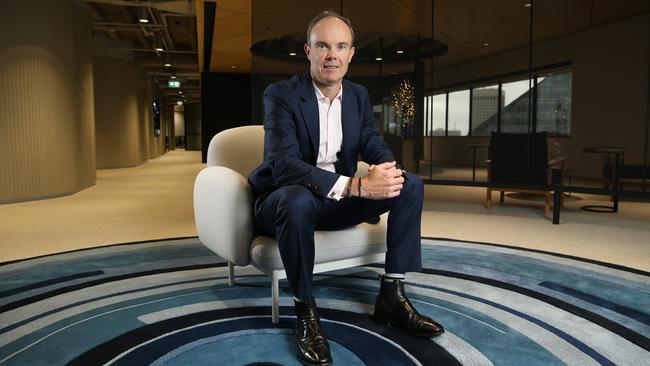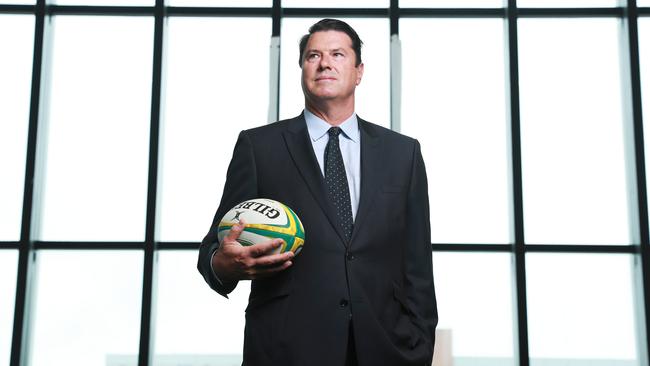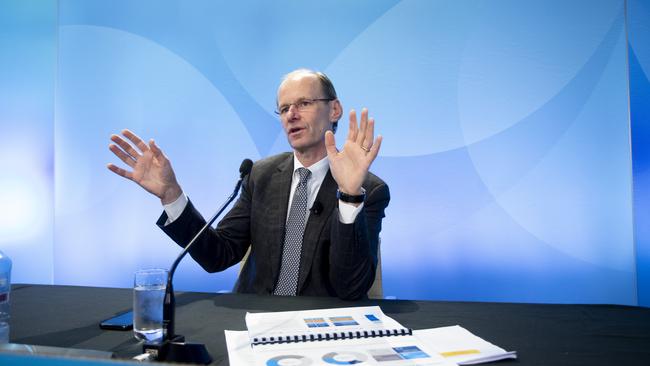
“People need to understand that equities in the short term can be very, very volatile,” Douglass told an investment conference, pointing out that people don’t check in for a daily valuation of their own house.
“If you think about it, what you own hasn’t changed at all, you still have the same interest in those businesses with the same prospects of those future profits,” he said.
His comments were aimed shrugging off Magellan’s major exposure to Netflix, which a week earlier had lost 20 per cent of its value in a single session. Just hours after he spoke Magellan’s other large exposure – Facebook – suffered a record $US230bn ($324bn) wipeout.
Three trading days later Magellan had another eye-watering market plunge, closing down 11 per cent at a seven-year low of $16.43 as Douglass stepped aside for medical leave. The move follows the recent public separation with his wife and will allow Douglass to prioritise this health.
The latest losses mean since the start of July Magellan’s shares have fallen 70 per cent. The ASX 200 is down 2.1 per cent over the same period.
The business behind the one-time star stock picker is being valued by investors as though another $40bn in funds is about to walk out of the door, compared to the $93.5bn it oversees now. Magellan’s new chair Hamish McLennan has plenty of work to do.
In December this column urged Douglass to step back, not double down. With Magellan in desperate need of an overhaul, Douglass simply couldn’t continue to hold the dual role of executive chair and continue as the chief investment officer while the underperforming fund manager was bleeding so much cash.

The usually sticky retail investors are also now starting to pull funds from Magellan’s flagship funds with nearly $1bn leaving in the past three months. This comes on the back of $22bn being pulled by institutional funds including the multibillion dollar St James’s Place mandate.
While there is short-term pain, investors should welcome McLennan’s first move to restore much-needed governance and bulk up the board as well as the optics of supporting Douglass stepping aside to take medical leave.
The messages are twofold – governance starts at the top and no single person is bigger than Magellan. The next pressure point for Magellan is February 17 when it is scheduled to deliver its first-half results and shine a light on how deeply the fund manager has been cutting fees. With Douglass sitting out for now this gives Magellan some clear air.
The rebuilding of investor confidence in the flagship global funds starts now under former UBS Australia boss Chris Mackay – the Magellan co-founder who has been overseeing the listed $2bn MFF Capital Investments in recent years while the focus remained on Douglass.
While Mackay is formally an adviser to Magellan, he has been overseeing the fund manager’s equities teams including Gerald Stack and John Sevior while Douglass was in Europe for much of the second half of last year.
Douglass has kept up appearances in recent weeks with a busy diary, including last Thursday’s presentation at a Morningstar financial conference. Late last month he recorded another live investor update where he walked through global inflationary outlook, the tech bubble building and revealed he had been trimming his holding in Facebook. Here Douglass noted the tech giant was facing more competition for younger users from other social media platforms including TikTok and Snap.
Douglass also said that he was living at his Southern Highlands farm with his wife and family while the Omicron wave was keeping everyone away from Magellan’s Martin Place office.
–
HOME LOAN DILEMMA
ANZ chief Shayne Elliott is paying the price for his bank dropping the ball on mortgages through the Covid pandemic as he is forced to play catch up on lost market share.
On the heels of Westpac’s quarterly update when it also revealed the toll of staying competitive on fixed mortgages, ANZ is also feeling the profit pinch.
ANZ is still undercutting rivals in pricing on the hotly contested three-year fixed mortgages and its flagship variable lending rate remains rock bottom.
Indeed, ANZ is the only one of the majors that hasn’t hiked fixed rates since January 1, which means it is the only major with three-year fixed mortgages below the 3 per cent mark.
This is likely to change in coming weeks, with the market response to ANZ’s third quarter update swift with shares in the bank down 2.4 per cent
In its earnings update ANZ said its net interest margin was down 8 basis points in the December quarter, with most of the losses coming towards the end of last year. Last week Westpac said some 10 points were sliced from its mortgage margins during the quarter, adding that margins were likely to remain under pressure for the rest of the financial year. Commonwealth Bank will provide some insight when it delivers its first-half results on Wednesday.
ANZ and Westpac had the most ground to make up after being caught unprepared for the rush for mortgages when pricing was being slashed. ANZ was particularly vulnerable with well-publicised delays in processing times.

To show how far behind ANZ is in the race, at the end of December its three-month annualised growth rate in mortgages was running at just 0.2 per cent. Westpac was at 2.5 per cent while the broader banking sector was booming at 8.9 per cent.
According to figures prepared for The Australian by mortgage tracker RateCity, more than 40 banks have raised three-year fixed mortgages since the start of January. This includes CBA, NAB and more recently Westpac drifting back towards the pack on pricing.
Still, ANZ and Westpac are going head to head on pricing on one, two and five-year rates. The two banks are also the lowest priced of the majors on variable rates.
This suggests Ross McEwan’s NAB, and Matt Comyn’s CBA will be largely protected from the worst of the mortgage margin squeeze.
Essentially all banks are now working through the fixed mortgage hangover from the ultra-cheap funding provided by the Reserve Bank through the depths of the Covid crisis. The so-called Term Funding Facility gave all banks access to tens of billions of dollars of heavily discounted borrowings so they could write low-fixed rate mortgages. The decision around mortgages was designed to give borrowers confidence they won’t be left exposed to rising interest rates for several years.
However, when the RBA turned the tap off last June, banks were forced to return to global money markets where pricing on wholesale money was rising, particularly from October.
At the time the major banks – mostly led by Westpac – remained in a brutal market share battle on fixed mortgages and were reluctant to pass on the higher pricing. Given there had been few levers to pull on the deposit side, this added to the profit pain.
Interest margins are an important driver of future profits for banks and given their giant lending books, even small changes can have a major impact on earnings. Westpac is hacking into its cost base to also protect the bottom line.
The key for investors is whether profit margins will start to expand again. While they are under pressure, this is already starting to happen with banks quietly pushing up fixed mortgage rates since the start of this year. According to RateCity the average price on a three-year fixed home loan is 3.15 per cent against 2.08 per cent this time last year.
ANZ said it had made “solid progress” in Australia to improve wait times for mortgage applications – saying this was now in line with other major banks. Clearly work still needs to be done for more complex loans where “efforts continue”. New applications in fixed loans are running at about 40 per cent during January.
Meanwhile ANZ was offering a sweetener by dangling the prospect of increasing the size of its current share buyback program, but in a market where valuations have been severely stretched investors are clearly wanting something with substance.








Just a few days ago Magellan’s Hamish Douglass was urging mum and dad investors to ignore the daily “emotional experience” of the sharemarket rollercoaster.